Elizabeth Arden (post 1945)
Continued from: Elizabeth Arden (1930-1945)
Compared with Helena Rubinstein, Elizabeth Arden emerged relatively unscathed from the Second World War. Arden’s businesses had been disrupted and some European operations had been lost and needed reestablishing but the salon and offices in London had escaped the Blitz and the one in Paris had stayed open right through the German occupation. Her sister, Gladys Maublanc de Boisboucher, had been interned by the Germans in 1944 but survived the war.
Fashion floor
Arden continued to pursue the business venture, creating designer clothes exclusive to her salons, she had started during the war. After falling out with Charles James [1906-1978] – the designer she had started with in 1943 – she tried designing clothes herself but when these were unsuccessful hired Antonio Castillo [1908-1984] on the recommendation of her sister Gladys. Other designers for the fashion floor that followed included Jean Dessès [1904-1970], Ferdinando Sarmi [b. 1912] and Oscar de la Renta [1932-2014].
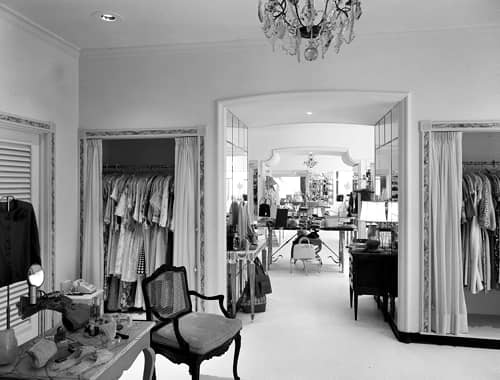
Above: 1959 Interior of the Elizabeth Arden salon on Worth Avenue, Palm Beach with house coats, hostess robes and other items of clothing on display. American salons that stocked similar items included New York, Boston, Philadelphia, Washington, Chicago, San Francisco, Hollywood and Miami.
Horse racing
Arden’s other major distraction from her cosmetic empire was horse racing. After buying her first thoroughbred, How High, in Saratoga in 1931, she had made further purchases, racing them first through her Mr Nightingale and later her Maine Chance stables.
In addition to improving her social standing, Arden’s interest in horse racing began to pay off financially in the 1940s. After hiring a new trainer Robert Thomas ‘Tom’ Smith in 1944, her winnings jumped to US$589,170 in 1945 making Maine Chance the most profitable stable in the United States for that year (Woodhead, 2003, p. 300).

Above: 1947 Elizabeth Arden joins her trainer, Tom Smith [1897-1957], jockey Eric Guerin [1924-1993] and Jet Pilot in the winner’s circle at the Kentucky Derby.
Horse racing also got Arden on the cover of the May, 1946 edition of TIME magazine, the first woman to be featured in this way by the magazine.
Maine Chance
In 1946, Arden opened a second Maine Chance health farm in Phoenix, Arizona. Its services were similar to those available at the resort in Maine and included a range of beauty treatments including a daily hairdo, manicure or pedicure, massage and heat treatments, skin and facial care and other luxury health services. However, the emphasis was also on weight reduction with most women coming to the resort being put on a strict diet. There were also daily exercise routines in a warmed pool and the exercise room as well as a range of sporting activities.
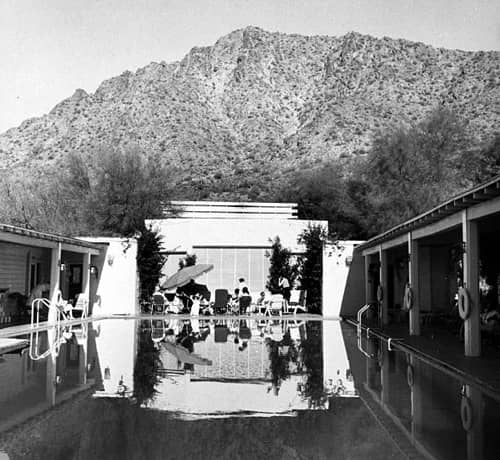
Above: 1954 Exercise pool at the Maine Chance Health Resort in Arizona. The building at the back houses the exercise room. Camelback Mountain is in the background.
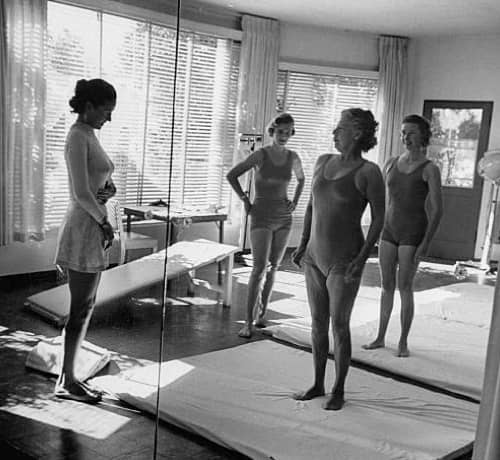
Above: 1954 Exercise room at Maine Chance, Arizona as seen in the mirror at one end of the room.
The Arizona resort operated in the northern winter when the resort in Maine was closed. This allowed Arden to ship staff and other resources between Maine and Arizona and rationalise some costs. Despite this, reports suggest that both facilities made little or no profit.
Company developments
Arden continued to expand her operations in the Americas after the war establishing three Delaware companies to handle her business in Mexico (1946), Cuba (1946) and Columbia (1948). However, her South American businesses were not without their difficulties with her salon in Santiago, Chile closing by the end of the decade.
There were also some operational changes in the United States. In 1948, the Elizabeth Arden Sales Corporation leased the Long Island manufacturing plant from Elizabeth, Arden Inc., and from then on was responsible for the manufacture of Elizabeth Arden cosmetics.
Arden for Men
In 1956, Arden introduced her first men’s range, Arden for Men. Packaged in gold and charcoal containers and scented with sandalwood, the line consisted of Talc, After Shave Lotion, Foam Shaving Cream, Cologne, and Hand and Bath Soap with other products added later. Like other toiletries in this category most of these were bought by women for men as presents for Father’s Day and Christmas.
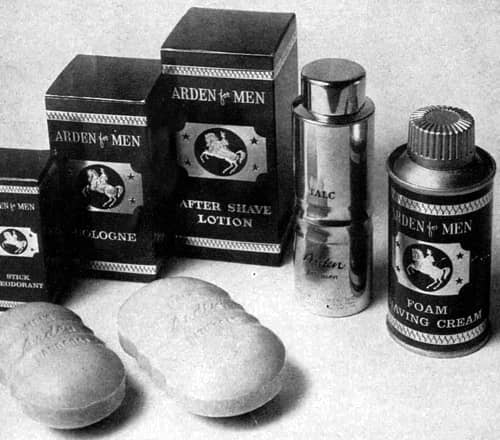
Above: 1957 Arden for Men Stick Deodorant, Cologne, After Shave Lotion, Invisible Talc, Foam Shaving Cream, and Hand and Bath Soap.
Salon treatments
An examination of the treatments provided by Elizabeth Arden salons after the Second World War reveals very little that was new. The salons continued to offer massage, manicure, pedicure and other body treatments, as well as facials, and make-up analysis. Arden also continued to offer exercise classes and other weight-reduction treatments in salons where facilities had been installed.
You can have a beautiful new figure. Come to the Elizabeth Arden Salon and let an expert help you trim inches off your body. Our series of corrective exercises perform miracles, whittle your waistline to perfect proportions, trim and subtract inches from your arms and legs and correct fat between your shoulders and neck.
(Elizabeth Arden advertisement, 1957)
Hair Styling
The most radical salon changes were in hair-care, namely the addition of permanent waving, coiffure styling and hair colouring services. Arden had already installed hairdressing facilities in a number of her American salons in the 1930s and after the war she added hairdressing salons to other establishments around the world.
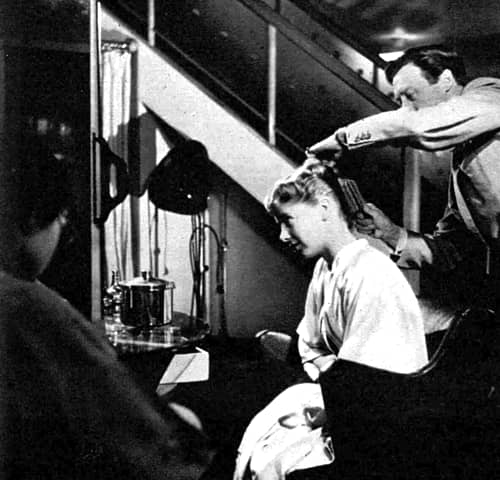
Above: 1952 Hair stylist at work in the London salon of Elizabeth Arden.
Elizabeth Arden permanent wave shapes the straightest hair into soft, gentle, natural waves . . . encourages the silken gleam of a well-groomed head . . . gives body to your hair firmly yet effortlessly. Given by a salon expert . . . each Elizabeth Arden permanent is put in with a special finesse that keeps the airiest setting impeccable for a long . . . long time!
(Elizabeth Arden advertisement, 1956)
Facials
The much publicised Intra-Cellular Mask seems to have been quietly shelved by 1950 but other facial treatments available before the war – Muscle Strapping Treatment, Anti-Brown Masque, Ardena Masque, Velva Cream Masque, Egg and Oil Treatment, and Firmo-Lift Treatment – remained salon staples right through to the 1960s. Many of these salon treatments used skin-care cosmetics that Arden also made available for home treatments.
Muscle Strapping Treatment: “This, the basis of every Elizabeth Arden Treatment, emphasizes the fundamental importance of cleansing, toning and nourishing. It moulds the contour of the face, firms the skin and muscles, improves the circulation. The tissues of the face and throat are nourished with rich, penetrating creams, braced by refreshing tonics. Finally, an exquisitely natural make-up, applied with a delicate artistry that conceals imperfections and enhances your best features.”
Anti-Brown Masque: “Initially designed as an after-summer treatment for removing marks of fading tan, it has become famous as a circulation treatment, to bring beauty to a sallow complexion. Not only does it bleach, but it stirs up sluggish circulation, bringing new vigour to every tissue. Dull skins become bright and clear, skin texture is refined, the whole face looks fresh and glowing. Marks of tan or little discolourations are banished. It is recommended not only for the face, but for arms and shoulders, so that they look smooth and lovely with evening décolletée or sleeveless summer dresses.”
Ardena Masque: “This is the Masque that has helped so many who are troubled with coarse pores or blemishes to regain a clear skin, and with it, self confidence and poise. The Ardena Masque purifies and clears the skin subject to eruptions and blackheads, refines the coarse oily one, tightens up flabby muscles, and under its beneficial influence a blemished skin becomes fresh and attractive.”
Velva Cream Masque: “It is a delightful treatment for all complexions. This cool, light Masque is so gentle that it suits the most sensitive skin, yet it is remarkably effective. It helps to relieve puffiness, to refine the skin and gives to the whole face freshness and re-awakened beauty.”
Egg and Oil Treatment: “This is ideal for any skin, but especially for the dry sensitive one. A blend of fresh eggs, with their firming properties, toning ingredients and soothing oils, its gentle action softens lines, whitens and smooths the skin leaving it refreshed and soothed.”
Firmo-Lift Treatment: “The perfect treatment for the mature skin, or if through illness, over-fatigue or strain, the face has lost something of its youthful freshness and clear-cut outline. Firmo-Lift Salon Treatment Oil and Firmo-Lift Lotion, moulded into the face and neck, help to firm drooping contours and sagging tissues, soften lines around the eyes and mouth, and bring back the serene loveliness of youth.”
Some new facial treatments were introduced but these simply incorporated new skin-care cosmetics into existing facial routines. For example, the Crème Extrordinaire Treatment just added Crème Extrordinaire – a night cream discussed later on – on the end of the existing Firmo-Lift Treatment.
Crème Extrordinaire Treatment: “This wonderful treatment combines the moisturising, acid neutralising and rejuvenating benefits of Crème Extrordinaire with the bracing and tightening effect of the Firmo-Lift Treatment. With deft, trained fingers of the expert, Firmo-Lift Lotion and Firmo-Life Salon Treatment Oil are worked upwards along the muscles of the neck and face firming and tightening the underlying tissues. Crème Extrordinaire is then patted into the skin leaving it invigorated, firm and astonishingly smooth . . . truly a treatment that is unsurpassed for preserving the youthful texture and radiance of the skin.”
Also see company the booklet: Salon Treatments (c.1959)
Skin-care
Additions to the Elizabeth Arden skin-care range after the war were very conservative. With the exception of hormones and vitamins, Arden ignored the ‘miracle’ ingredients in vogue in the 1950s – such as royal jelly and placental extracts – and continued to rely, for the most part, on products formulated with astringents and oils, combining them with patters and straps.
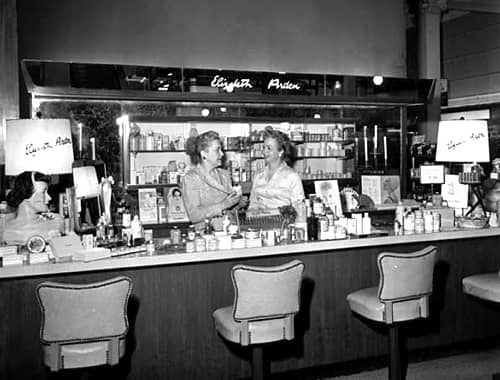
Above: 1957 Elizabeth Arden counter in the Powers department store in Minneapolis. Note the chin strap on the left.
Elizabeth Arden’s 3-Way Plan
Special Astringent used with a cotton patter: stimulates sluggish circulation, wakes up lazy facial muscles, helps tone lax, sagging tissues. … [M]ake one of the wonderful cotton patters . . . use it as least 5 minutes daily after cleansing for best results.
Chin Strap plus daily treatment bolsters relaxed chin tissue, helps correct a double chin, encourages muscle resistance, helps strengthen tissues. Be sure to ask about the special neck moulding exercises.
Firmo-Lift Treatment helps remould contours like magic. Enriches dry skin, helps smooth away surface lines, wrinkles, crow’s feet; helps correct heaviness at jaw and neck. Firmo-Lift Lotion, Special Salon Oil and vitamin-filled Perfection Cream, plus proper application with your own two hands, will produce wonders in just a few days.(Elizabeth Arden advertisement, 1956)
Skin regimes
Understandably, Arden did not take up Helena Rubinstein’s idea of a ‘combination’ skin and generally stuck to the three standard skin types – Normal, Oily and Dry – with Dry often, but not always, associated with Mature skin, and Oily with Blemished or Young skin.
In the United States, the ‘Cleanse, Tone and Nourish’ skin-care routines Arden had recommended for each skin type had become ‘Cleanse, Refresh, and Smooth’ after the 1938 Food, Cosmetic and Drug Act (FD&CA) placed limits on allowable cosmetic claims there. Elsewhere, the message of ‘Cleanse, Tone and Nourish’ continued on as before.
In 1945, Elizabeth Arden had two cleansers in her range, the older Ardena Cleansing Cream and the more recent Ardena Fluffy Cleansing Cream. In 1946, Arden added Milky Liquid Cleanser as a quick make-up remover or as a cleanser for oily or blemished skin types. Later known as Skin Deep Liquid Cleanser in the United States it was used in the Speedbird amenity kits Arden developed for the British Overseas Airways Corporation (BOAC).
Skin Deep Liquid Cleanser: “A liquid cleanser that leaves your skin flawlessly clean and silken-smooth in seconds! Created with unusual solvent properties, it dislodges skin-deep impurities . . . lifts soil to the surface, instantly.”
See also: Airline Amenity Kits
In 1963, Arden added a second cleanser for younger, blemished skins called Special Cleansing Cream. Renamed Complexion Clear in 1966, it included a mild antiseptic to act as an antibacterial.
Special Cleansing Cream/Complexion Clear: “[A] cleansing cream that balances the amount of oil pores produce so it can properly cleanse and heal blemishes.”
In 1948, Arden added Velva Smooth Lotion, yet another astringent lotion, this one for sensitive or blemished skins. Like her two earlier astringents – Ardena Skin Tonic and Ardena Special Astringent – it was applied with pad of cotton wool moistened with cold water but, unlike them, Arden did not suggest applying it using the Astringent Patter, perhaps considering its use ‘too stimulating’.
Velva Smooth Lotion: “[A]n especially soothing, cooling, mildly astringent lotion for blemished or sensitive skins.”
To the exisiting Ardena Velva Cream and Ardena Orange Skin Cream, Arden introduced Ardena Perfection Cream (1946) for mature skin types. It contained vitamins A and D as well as ‘a rich, firming oil’. In Britain and Australia it was sold as Ardena Vitamin Cream, possibly because Arden’s rival, Helena Rubinstein, already marketed a Perfection Cream there.
Ardena Perfection Cream: “The smoothing cream, rich in vitamins. Of super-rich oils fortified with beneficial vitamins for all types of skin—but especially for thin or mature faces which have lost elasticity and tone. When used on delicate areas around mouth and eyes, it helps banish little lines and wrinkles.”
Arden recommended that Perfection Cream be applied with her new Electric Patter, sometimes referred to as the Pit-a-Pat. Like the earlier Frances Jordan Reducer and the Giant Roller, it was not a new invention nor was it made by Arden.
Elizabeth Arden Electric Patter: “Tiny padded ‘fingers’ stroke deftly to help stimulate circulation. Use it with its rich emollient partner, Ardena Perfection Cream, and pat . . . up . . . up to your very hairline. Your skin will tingle, seem to spring to life with a wonderful new glow.”
See also: Patters
Moisturisers
The first Arden product with moisture in its name was Ardena Moisture Cream (1941) which could be used as a quick pick-up to refresh tired skin.
Moisture Cream: “[A] rare blend . . . it is actually made of fresh eggs and looks and smells good enough to eat.”
In 1950, Arden combined Ardena Moisture Cream with Ardena Moisture Oil into create a Moisture Treatment for dry skin. The Moisture Oil appears to have been Ardena Muscle Oil under a different name. The name change was made necessary in the United States due to the strictures imposed by the Food and Drug Administration (FDA) after 1938. Arden adopted the new name in other countries as well when she introduced the Moisture Treatment there, perhaps to suggest that the two products were part of a holistic treatment.
Only Elizabeth Arden, who has devoted her life to beauty, could create this treatment. In one fleeting week, it makes sundry or naturally-dry skin . . . radiantly soft, fresh, moist. Care lines and wrinkles seem to disappear.
Smooth on Elizabeth Arden’s Moisture Oil, a soothing, firming, kind-to-skin oil.
Then, Elizabeth Arden’s Moisture Cream, a rare blend . . . it is actually made of fresh eggs, and looks and smells good enough to eat!
Leave it on for 30 minutes, tissue it off . . . and . . . incredible surprise . . . dry skin comes off, and your skin looks exquisitely fresh and moist!(Elizabeth Arden advertisement, 1950)
Although, Ardena Moisture Cream and Ardena Moisture Oil have moisture in their name they were not moisturisers, a class of cosmetics that first appeared in the 1950s.
See also: Moisturisers
Arden’s first moisturiser was Velva Moisture Film introduced in 1956. Arden brought Guy Nicolet – a make-up expert from the Paris salon – to introduce the product into the United States. It could be used under a foundation but was also recommended as a general body lotion.
Velva Moisture Film: “[A] completely new beauty dimension, an invisible protective film that moisturizes skin, leaving it smoother, younger-looking. This gentle lasting transparent film is to be used before foundation.”
In 1962, Arden also added Ardena Body Cream as a moisturising, after-bath treatment.
Body Cream: “[Y]our skin feels smooth and supple in an instant, virtually renewed because it has been moisturised—deep, deep, deep. Marvellous for arms, legs and backs . . . use it after the bath or as a fragrant massage—heavenly!”
Firmo-lift
In 1949, Arden announced that she was releasing the cosmetics used in her Firmo-Lift salon treatments for general sale in the American market and then made them available world-wide. The home treatment used Special Salon Treatment Lotion and Special Salon Treatment Oil followed by Ardena Perfection Cream but, in 1951, Arden replaced Special Salon Treatment Lotion with Firmo-Lift Treatment Lotion.
Elizabeth Arden, one of the world's foremost beauty authorities, has added to her extensive cosmetic line a new lotion that she says will work magic against wrinkles, sagging contours, puffiness and age lines.
The lotion, Firmo-lift, is the streamlined version of a treatment she has had for a number of years. The old treatment was a combination of lotion and oil, followed by a softening cream.
With the 1951 version of the Firmo-lift treatment, you simply spread the light, slightly oily lotion over your face and neck. The oil will disappear immediately. Put it on with firm, upward strokes.(Elizabeth Arden advertisement, 1951)
Despite suggestions that this was a new lotion and a ‘simplified treatment’ it appears to have been largely another name change. The recommended home treatment regime continued to include Special Salon Treatment Oil and Perfection Cream, and remained that way right through to the late 1960s.
To make your neck more swan-like and to keep your skin from letting you down, Elizabeth Arden has created the superb Firmo-Lift Treatment. After cleansing the skin thoroughly, pour Firmo-Lift Lotion on a dampened pad and smooth against the skin with a deep upward motion. Stroke the neck from chin to cheekbone, from brow to forehead. The skin will feel firm, ready for Special Salon Treatment Oil. Pour a little in the palm of your hand and smooth over neck and face until all the oil is absorbed. This precious oil helps erase deep lines and reduce puffy areas and firm up (or prevent) a double chin. Lastly, smooth on Perfection Cream—a rich, rare cream that helps nurture the skin. Pat it over the face and throat for a new supple softness. Go through this Firmo-Lift Treatment every day and see how simple it is, how simply sensational your skin texture and contour is!
(Elizabeth Arden advertisement, 1968)
Hormones
By the 1950s, hormones had become an established part of the skin-care market with numerous companies retailing oestrogenic skin creams. Helena Rubinstein had updated her Hormone Twin Youthifiers with the Estrogenic Hormone Twins in 1945 and then added Estrogenic Hormone Hand Lotion and Estrolar Throat Oil in 1948. Elizabeth Arden followed much later, replacing her Gland Cream with Ardena Special Hormone Cream with natural oestrogens late in 1951 and then adding the pink-coloured Ardena Hormone Hand Cream early in 1952.
Ardena Special Hormone Cream: “A new combination of natural estrogenic substances which will help to revitalize your skin, keep it firm, alive, fresh and clear in color.”
Ardena Hormone Hand Cream: “[A]n exceptionally rich emollient-cream fortified with natural, hormones to keep, hands vitally younger, firmer, textured, softer, smoother AND it lightens freckles, brown spots, discolorations.”
Arden also added oestrogenic hormones to Basic Sheen, a liquid foundation, in 1953.
Night Creams
Arden’s only ‘miracle cream’ of the decade was Crème Extrordinaire (1958), a relatively high-priced, night cream suitable for all skin types. Originally sold in porcelain apothecary jars, the largest size was later replaced with a plastic container.
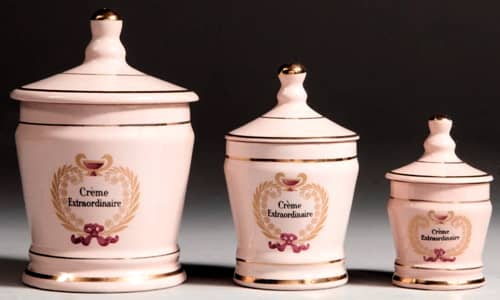
Above: French versions of Crème Extrordinaire – labelled Crème Extraordinaire – sold in a porcelain apothecary jars.
Said to be rapidly absorbed and penetrate deeply, Crème Extrordinaire was claimed to do the work of three creams, smoothing, moisturising and nourishing the skin while neutralising any tendency to over acidity.
Crème Extrordinaire: “Satiny lightness filled with all the ingredients to encourage fresh young skin texture . . . free of lines, wrinkles, dryness and puffiness.”
Directions for applying the cream were as below:
First cleanse the skin thoroughly using a moistened cotton pad with Ardena Cleansing Cream and Ardena Skin Tonic. Remove all remaining cream with tissue. Pat the skin briskly with Skin Tonic or Velva Smooth Lotion. Dry thoroughly. Smooth on Crème Extrordinaire lightly, using a small amount as it is absorbed quickly. Smooth on carefully over the whole face (with the exception of the nose*) . . . concentrating carefully on the little lines that span out from the eyes to the temple . . . and the lines between the eyes. Pat in well, always with upward strokes. Leave on overnight.
*On the area of the nose, use a little Pore Cream to smooth ans soften the texture. This is suggested because of the special richness of Crème Extrordinaire. Leave on overnight an see the extraordinary transformation of your skin after two applications!(Elizabeth Arden, c.1958)
Crème Extrordinaire was not Arden’s only night cream. As well as the older Ardena Orange Skin Cream and Ardena Velva Cream, Arden added Liquid Night Cream (1964) and Beauty Sleep (1967), the later product known as Night Beauty in Australia and elsewhere.
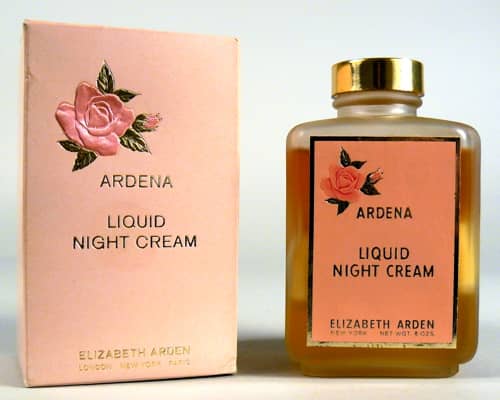
Above: Ardena Liquid Night Cream (Smithsonian).
Liquid Night Cream: “For every woman who prefers a cream in liquid form—without sacrificing any of the remarkable moisturizing properties and rich emollients which, until now, only a regular cream could provide. This delicate golden liquid is quickly absorbed into the skin to work all night long unseen, nurturing the tissues, imparting precious moisture, easing lines and smoothing away all trace of flakiness.”
Beauty Sleep: “[A] dream-light cream that goes deeply into the skin, bathing it with invisible moisture and gentle oils all night long. Reviving tired complexions for a lovely awakening.”
Youth market
Most of the skin-care cosmetics mentioned above were designed for mature skin types. Arden had a number of skin-care products for blemished or oily skin but these were not aimed specifically to the skin-care needs of adolescents.
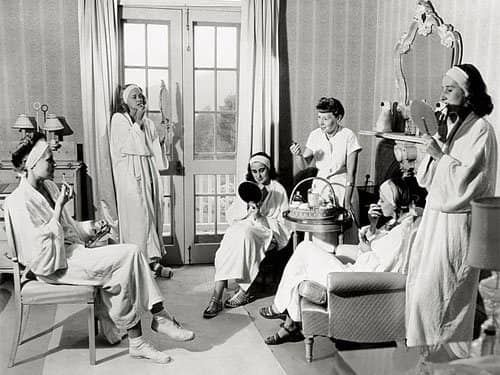
Above: 1952 One of a series of photos taken to promote the idea that college girls might have a beauty-and-fun vacation at Maine Chance health spa in Maine. Arden also reduced the price to US$200 for a week’s stay, down from US$600. I doubt there were many takers.
In 1960, the British arm of Elizabeth Arden – who were perhaps a little more in touch with youth culture – released a boxed set – a ‘Disc-Course on Beauty’ – containing eight skin-care and make-up products suitable for younger skins along with a 45 r.p.m. record describing how to use them. A similar boxed set with a record was released in the United States the following year as the ‘Sounds of Beauty’ with a wider range of cosmetics. Neither package seems to have been successful in attracting the growing teenage market to Elizabeth Arden.
In the 1960s, a number of companies developed medicated skin-care and make-up lines for teenagers and younger women market. Examples included Noxzema’s Cover Girl (1961), Helena Rubinstein’s Clear and Lovely (1961), Revlon’s Natural Wonder (1962) and Max Factor’s Pure Magic (1962) ranges. Arden made almost no attempt to compete with these, her only development being the previously mentioned Special Cleansing Cream (1963) – later renamed Complexion Clear – which included a mild antiseptic.
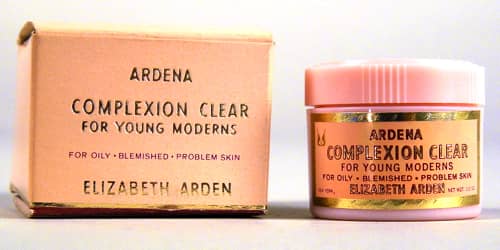
Above: Ardena Complexion Clear for Young Moderns (Smithsonian)
Sun products
The Ardena sun preparations available in 1945 were Sunpruf Cream (1933), Suntan Oil (1933), Protecta Cream (1928) and Sun Gelée, the last product being Ski-Sports Gelée (1939) under a different name.
New sun products added after the war included Sun Bloc Lotion (1952), Suntan Cream and Suntan Lotion (1956), both aerosols, and the Sun Control (1963), a moisturising, waterproof emulsion.
Sun Bloc Lotion: “A light, non-oily liquid which prevents both tanning and burning, yet keeps the skin soft and fair.”
Sun Tan Lotion: “[T]ans oily-type skins perfectly. Stays on in salt water. Aerosol container.”
Sun Tan Cream: “[A] foam cream for dry, sensitive skins. Softens and moisturizes as it tans. Aerosol container.”
Sun Control: “[S]creens out harmful sun rays and helps keep skin from burning, peeling or drying.”
Arden also promoted Velva Leg Film (1941) as a stocking substitute for the beach. In 1945, she added Velva Leg Film Buffer to improve the finished look of Leg Film and also suggested using Sleek depilatory (1941) to remove hair before the Leg Film was applied.
Velva Leg Film Buffer: “[F]or polishing after applying Velva Leg Film. Must be thoroughly dry, then buff lightly for a sheer-textured finish.”
In 1961, Velva Leg Film was superseded with Secret Cover, a waterproof body and leg make-up. Like the earlier Velva Leg Film it came in Light, Medium and Dark tones and was sold with a buffer.
Secret Cover: “[S]tainproof, won’t come off on clothes, and it’s so water-repellent it ‘stays put’ even when you swim or shower. You simply rub it over your skin until it is smoothed on evenly . . . let it dry for a few minutes, then polish to a satiny sheen with the special Ardena buffer.” Shades: Sun Beige, Sun Bronze and Sun Copper.
Make-up
Arden did not abandon the idea of matching make-up with clothing after the war but did not restart publishing annual colour charts. Like Revlon, Arden now promoted her new make-up shades as fashion items in themselves and gave suggestions for clothing colours that would best go with them. The example below is for the Fraises des Bois shade of lipstick (1960):
Spring’s sparkling lipstick colour . . . a delicious wild strawberry pink to go with all the newest spring-and-summer colors. Wear it charmingly with tones from the Sugar Beiges and Browns and Chilled Fruit Pinks and Reds to the Tonic Greens and Field-and-Fountain Blues!
(Elizabeth Arden advertisement, 1960)
Foundations and powders
In 1945, Arden introduced Pat-A-Kake cake make-up in nine shades, increased to thirteen by 1947. Applied with a pad soaked in Ardena Skin Lotion rather than water, it lay somewhere between a water-soluble pancake and a liquid cream make-up.
Pat-A-Kake: “[T]o be used as a complete makeup or as a base, for a younger, smoother, softer-looking skin . . . helps to conceal blemishes, freckles, tiny lines without giving an artificial, heavily-coated look.” Shades (1947): Rachel, Rose Rachel, Dark Rachel, Light Rosetta Bronze, Dark Rosetta Bronze, Daytime Camellia, Evening Camellia, Natural, Rosetta Medium, Rosee Day, Rosee Evening, Dark Rose Rachel, and Summer Sun.
Unfortunately for Arden, Max Factor took umbrage with the name and she was forced to subsitute Pat-A-Kake with Pat-A-Créme in 1948. Although annoying, this was probably not a major loss as pancake make-up types were being largely superseded by cream compact powders such as Pond’s Angel Face (1946). Like Angel Face, Arden’s Pat-A-Créme was a solid, powder-cream foundation.
Pat-A-Créme: “The loveliest, smoothest, most flattering solid cream make-up you’ve ever used! Whether you smooth it on very lightly to tone your skin, or use it to cover completely every tiny line and blemish, it is a perfect joy!” Shades: Natural, Desert Pink, Desert Sun, Dark Rachel, Sungold, Dark Rose Rachel, Sun Drama, Dark Rosetta, Medium Rosetta, and Light Rosetta.
Other foundations added by Arden during the 1950s included: Ardena Basic Sheen (1951) an oil and pigment liquid foundation said to be suitable for all age groups, also made with a version containing hormones for women over thirty; and Veiled Radiance (1957) a creamy, liquid emulsion smoothed on with the finger tips.
Ardena Basic Sheen: “For the young luminous look! Smooth on this flowing cream foundation . . . every tiny line and imperfection seems to vanish. Your skin takes on a glowing translucent beauty!” Shades: Rose Rachel, Light Rosetta, Deep Rose Rachel and Rosetta Bronze. Rachel, and Medium Rosette added 1953.
Ardena Basic Basic Sheen with hormones: “For the woman over thirty. Elizabeth Arden adds vitalizing estrogenic hormones that help replenish aging tissues . . . help restore your complexion to radiant loveliness.”
Ardena Veiled Radiance: “[T]his radiant foundation has answered women’s need for a moisturizing cream make-up base . . . [G]lides on, melts into your skin, erases tiny blemishes—casts the delicate glow of great beauty on your face.” Shades: Rachel, Naturelle, Rose Rachel, Light Rosetta, Dark Rosetta, and Dark Rose Rachel.
By 1960, Arden therefore had at least twelve products that could be used as foundations: Amoretta Cream, Ultra Amoretta Cream, Lille Lotion, Crème de France, Lille de France, All-Day Foundation, Velva Moisture Film, Featherlight Foundation, Pat-A-Crème, Basic Sheen, and Veiled Radiance. There was also the older No-Shine (1929), a colourless liquid to prevent shine on the nose and forehead.
In 1953, Arden launched a new translucent face powder, Ardena Invisible Veil. This came in two forms, Ardena Invisible Veil Pressed Powder (1953), a solid, compact powder in seven shades packaged in Napoleonic style compacts; and Ardena Invisible Veil Face Powder (1954), a loose face powder in ten shades in a French Bouquet Box.
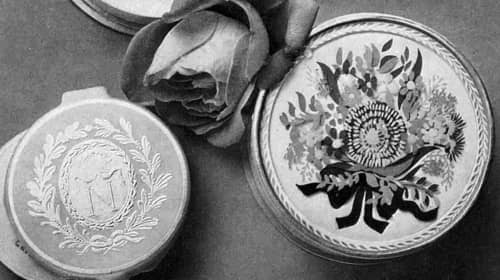
Above: 1955 Ardena Invisible Veil Compact and Face Powder. The Napoleonic style compacts came in black, white, red, pink and dark blue with the crown and laurel emblem embossed in gold.
Ardena Invisible Veil Pressed Powder:“[G]oes on with a soft mat finish, completely blocks out shadow, never flies or mists as you use!”
Ardena Invisible Veil Face Powder: “[A] loose powder with all the magic of famous Invisible Veil pressed powder! Unbelievably fine, delicately perfumed, it goes on softly, covers every shadow and pore, imparts a clear, luminous look.”
In 1966, Arden introduced Perfect Finish which removed the need for powdering at all. Suitable for all skin types it was sold in a plastic, spill-proof container with a swivel-top dispenser.
Perfect Finish: “Glides smoothly over the skin giving superb coverage without a mask-like finish. At the same time, it camouflages lines, shadows and blemishes, leaving the face with an even color and a subdued glow. It also works magic on such tell-tale signs of age as dark circles under the eyes.” Shades: Rachel, Rose Rachel, Light Rachel, Beige Jonquil, Sports Dark, and Sun Bronze.
Lipstick and rouge
Like other cosmetic companies Arden continued to add new shades of lipsticks each year, many with matching shades of rouge and nail polish. Those that I know of were: Rose Mist, and Red Grape (1945); Drama, and April-May (1946); Red Cactus, and Desert Pink (1947); Crimson Lilac, Sun Gold and Meditteranée (1948); Canary Red, Surprise, and Flamenco (1950); Striking (1951); Lido-Venice Pink, Pink Perfection, and Pink Perfection Plus (1953); Pure Red (1954); Oriental Pink, and Oriental Red (1955); Pink Pink, Summertime, Soleil des Alps, and Rose Aurora (1956); New Fashion, and Golden Poppy (1957); India Ruby, Rose Diamond, and Star Topaz (1958); Pure Pink, Pink Spark, Ember Red, Ananda Pink, Arden Pink, Rose Ceil and White Lustre (1959); Peace Rose, and Fraises des Bois (1960); Pink Jonquil, Mexican Fire, and Let’s Dance (1961); International, Golden Apricot, and Regal Red (1962); Wild Pink, Pink Amethyst, Dawn of Spring, and Saratoga Red (1963); Fragile, Sheik, Rose Orient, Flame, Candle Light, Natural Light, Peach Light, and Golden Light (1964); Beige Pink, Brilliance, and Sun Gold (1965); and Silver Jonquil, Pure Pure Red, Sea Orchid Light, and Sea Orchid Dark (1966).
In 1949, Arden introduced Super Lipstick, a creamy indelible made to a new ‘French formula’ in sixteen ‘costume-blends’ in Automatic and Jumbo cases as well as a longer version of the lipstick which debuted in 1950.
Super Lipstick: “Now . . . a lipstick with real ‘staying-on’ power. And because it stays longer; the stick lasts longer! This secret French blend is creamier, smoother; gives a new luminous brilliance of color.” Shades: Desert Pink, Blush Rose, Paradise Pink, Sky Blue Pink, Red Feather, Victory Red, Stop Red, Meditteranée, Magenta, Radiant Peony, Crimson Lilac, Schoolhouse Red, Drama, Telecast, Ruby and Sapphire.
Arden did not become heavily embroiled in the American ‘Lipstick Wars’ which began with the appearance of Hazel Bishop’s Lasting Lipstick in 1950.
See also: Lipstick Wars
While Revlon, Helena Rubinstein, Coty and others concentrated on promoting new lipstick formulations, Arden’s advertising efforts were centred on her ‘Two lipsticks are better than one’ campaign. Beginning in 1951, this promoted the practice of blending one lipstick colour over another, an extension of the two-powder technique she had used before the war.
Two Colors are Better Than One . . .
As an artist paints color over color to achieve a powerful vibrating quality . . . Miss Arden now creates beautiful combinations of colors in her famous velvety, creamy, non-drying Lipsticks with just the right amount of indelibility.
Buy two lipsticks – in these specially selected colors in a special “Better than One” package.(Elizabeth Arden advertisement, 1951)
Like her face powders, at first, Arden wrapped two complementary lipsticks together in a single package but, in 1952, she began selling double-headed Italian Duet Lipsticks in a range of coordinated shades.
Italian Duet Lipstick: “[A] single lipstick out of which four colors, may be created. You, yourself, make your own individual lipstick shades by applying one color over another. Each color can also be used singly.” Shades combinations: Blush Rose/Radiant Peony, Striking/Radiant Peony, Victory Red/Sky Blue Pink, Sun Gold/Red Cactus, Desert Pink/Paradise Pink, Paradise Pink/Sky Blue Pink, Paradise Pink/Blush Rose, and Stop Red/Red Cactus. Other combinations followed including: Sky Blue Pink/Red Feather, April-May/Montezuma Red, Surprise/Rose Mist, and Blush Rose/Radiant Peony.
The Duet Lipsticks were made with two jumbo-sized lipsticks but, in 1953, she added a Jewelled Duet case that used two longer-sized lipsticks.
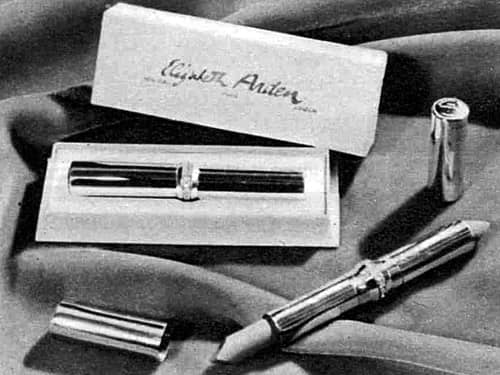
Above: 1953 Jewelled Duet Lipstick.
In 1956, Revlon released its Futurama refillable lipstick cases. The following year, Helena Rubinstein and Elizabeth Arden did the same, with the Arden refillable cartridges advertised as Click-Change.
Click-Change: “[T]he refill case that saves tempers and money. One twist and the used lipstick clicks out. Another twist and the refill clicks in. No messy hands. No scooping out. No squeezing in.”
Arden Click-Change refillables were cheaper than those sold by Revlon and Helena Rubinstein. This suggests she was not part of the agreement entered into by Revlon, Helena Rubinstein and others to fix the price of the cartridges.
Another Arden lipstick case worth mentioning was the Rolling Mirror Lipstick (1959). Like the earlier Looking-Glass Lipstick (1936), it had a small mirror built into the case.
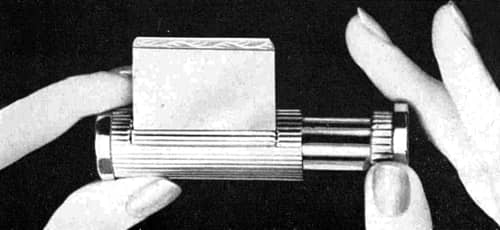
Above: 1960 Rolling Mirror Lipstick sold in gold, gold and silver, and gold, silver and jewelled cases.
Rolling Mirror Lipstick: “With one little twist out rolls a highly polished mirror to give you the clearest, most perfect image of your lips as you apply the creamy, lustrous, long-lasting Elizabeth Arden Lipstick.”
To complement her lipsticks Arden continued to sell both cream and compact rouges/blushes in shades introduced as new lipstick shades came on the market.
In 1963, Arden added Faint Blush, a pale, pink cream worn over a moisturiser but under a foundation. Used during the day, it was said to give the face a ‘healthy radiance’ while at night, under lights, it supposed to prevent the ‘tired, washed-out, zombie look’. It appears to have been superseded by Creme Blush (1967) which combined colour with a moisturiser.
For women who preferred a powder there was also Color Veil (1965), a compact blusher applied with a blending brush over foundation and powder around cheekbones, brows, earlobes and throat.
Faint Blush: “[A] delicate new hint of pink to whisper on your skin under make-up. Your complexion becomes radiantly clear and everything about you looks rosy.”
Creme Blush: “This creamy liquid veil of color should be smoothed over the entire face to achieve an overall naturalness. Creme Blush doesn’t cover but simply adds sheer color and glow while softening and smoothing the complexion. It also contains beneficial moisturising ingredients, so good for the skin all day long.”
Color Veil: “[A] new blusher which gives the face a soft focus radiance, is fluffed over the face with an artist’s brush of natural fur.” Shades: Blush of Rose, Golden Peach, True Warm Pink, Beige Rose, and Tawny Suntan.
Eye make-up
The most important post-war innovation in eye make-up was Helena Rubinstein’s Mascara-matic (1957). Two years later, Arden introduced a similar device, the Mascarette which followed Maybelline’s lead and used a spiral brush rather than the grooved applicator used in the Mascara-matic.
Mascarette: “[A] liquid mascara and a special spiral brush to darken lashes and give a new illusion of thickness and length.” Shades: Black, Light Brown, Dark Brown, Light Blue, and Green.
See also: Automatic Mascara
Like Rubinstein’s Mascara-matic the liquid mascara used in Arden’s Mascarette was waterproof but as she had neither invented the applicator nor the brush Arden gave it little advertising space, preferring to concentrate more on promoting her Eye Stopper (1949), an automatic eye pencil that came with its own sharpener. Here she beat both Helena Rubinstein – who did not introduce her Eye Autopencil, an automatic, refillable eyebrow pencil, until 1951 – and Maybelline – who did not develop one until 1957.

Above: Elizabeth Arden Eye Stopper.
Eye Stopper: “[T]he perfect make-up pencil to make eyes seem wider, brighter, lovelier, by the delicate underlining of eye-brows and eyelashes.” Shades: Black, Dark Brown, Brown, and Blue. Grey and Green added by 1951.
Other new Arden eye make-up included Kôhl (1955), a powdered, eye make-up sold in little glass flacons shaped like a miniature urn; White Liner (1959) an under-eye concealer; and Artificial Eyelashes.
Kôhl: “[A] new oriental eye make-up. The superfine powder is applied with a tiny wand. Shades: Brown, Blue, Grey-Black and Green.
White Liner: “[A]n opaque base which blends with your facial foundation and lightens the under-eye area.”
Artificial Eyelashes: “Made of natural hair woven on fine silken thread.” Colours: Black, Brown, Green, and Blue.
Arden also broadened the formulations of her eye shadows developing: Liquid Eye Shado (1959) in sixteen shades; Eye Shado Stick (1960) in twelve shades; and Cake Eye Shado (1964) in eight shades. When she added Cake Eye Shado she also introduced Cake Eye Liner in Black, Dark Brown, Gray Brown and Dark Gray shades.
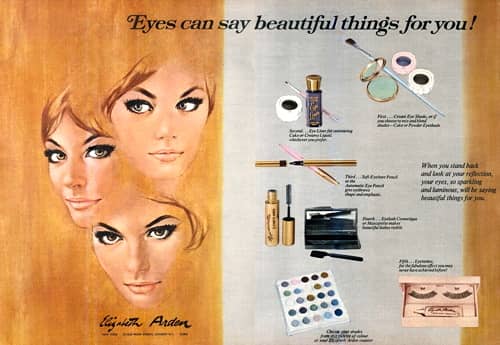
Above: 1966 Elizabeth Arden eye make-up. First: Cream, Cake or Powder Eye Shado; Second: Cake or Liquid Eye Liner; Third: Eyeliner Pencil or Automatic Eye Pencil; Fourth: Mascarette or Eyelash Cosmetique; and Fifth: Eyelashes.
Liquid Eye Shado: “[W]ith its own sable brush! Now you can brush subtle soft color on the lids to give depth, interest and reflected color.”
Eye Shado Stick: “[A] magic wand that draws a soft accent of pure creamy color close to the lashes. In a slender golden purse case.”
Cake Eye Shado: “[A]pplied like watercolor, it lends itself to the most subtle or dramatic effects.”
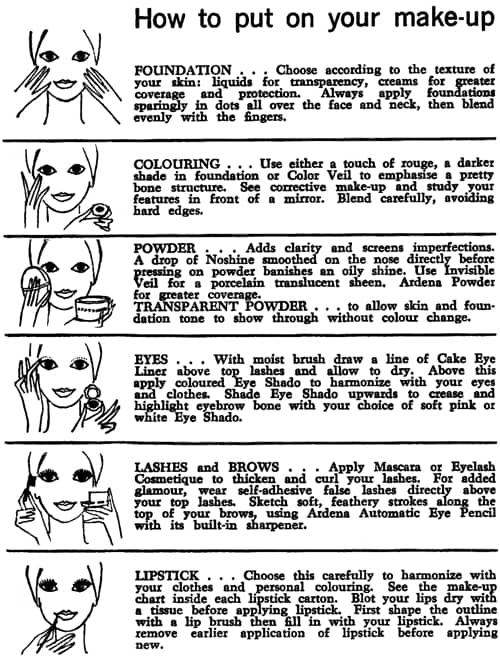
Above: c.1968 Elizabeth Arden. How to put on your make-up.
Transition and sale
In 1966 Elizabeth Arden died from complications following a stroke and pneumonia. Carl W. Gardiner who served as the executive vice president of Elizabeth Arden from 1948 to 1966 took over as president of the company on Arden’s death while Pablo Manzoni [b. c.1940] was made its creative director.
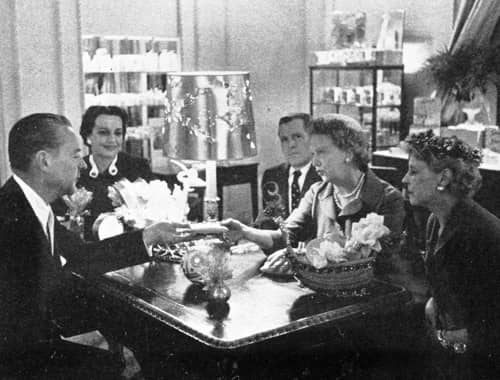
Above: Elizabeth Arden (right) discussing sales with Carl W. Gardiner [1905-1993] (left).
Arden owned 90% of Elizabeth Arden, Inc., and all of the capital stock of Elizabeth Arden Sales Corporation. Her will included US$11 million in bequests and the United States government billed the company for US$37 million in estate and corporate taxes. Elizabeth Arden was estimated to be grossing US$60 million per year when Arden died, but raising US$48 million to pay the taxes and bequests was going to be difficult.
The board began selling assets such as the old factory and warehouse in East 52nd Street, the Maine Chance Stable, Arden’s castle in Ireland, her private estate in Maine, and her New York apartment. The custom-made clothing department was also closed down as was the Maine Chance Health Spa in Maine. Finances were still tight and none of the legatees mention in Arden’s will had received any money by 1970. The one exception was Arden’s sister Gladys Maublanc de Boisboucher. Gladys had wisely sold her shareholding in Elizabeth Arden SA to the American board and traded her US$4 million inheritance from Arden’s will for US$2 million in cash in 1969, the year before her death in 1970.
In 1970, Carl Gardiner quit Elizabeth Arden and the company was then sold to Eli Lilly for US$38.5 million. However, an earlier offer by American Cyanamid for US$35 million resulted in court action which was not resolved until 1971. It was only then that Arden’s beneficiaries were paid.
After the sale to Eli Lilly, Cornelius Pettinga [1921-2001] became the new president of Elizabeth Arden followed by William A. Hanley Jr. [1923-2017] in 1972. The company posted losses of nearly US$7 million during the first four years under its new ownership (Allen, 1981, p. 101) but turned the corner latter in the decade under the presidency of James R. Zapapas [1926-2011] who was appointed in 1975. In 1986, Zapapas retired and the presidency passed to Joseph F. Ronchetti who had been working as executive vice-president of Elizabeth Arden for many years. Ronchetti had started with Elizabeth Arden after Arden died but before it was bought by Eli Lilly and is widely regarded as being responsible for revitalising Elizabeth Arden and creating the brand people are familiar with today.
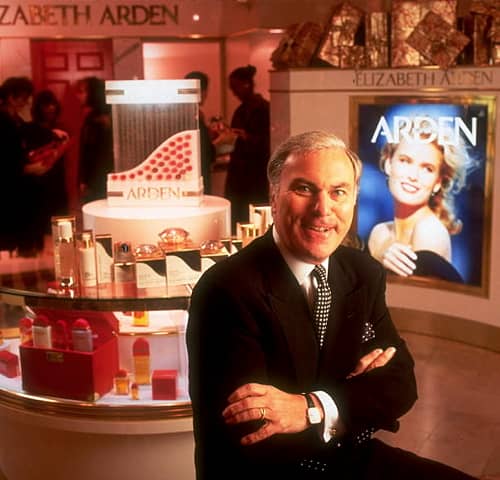
Above: Joseph F. Ronchetti [b. 1940].
Ronchetti stayed with Elizabeth Arden as its CEO and president as it went through two new owners – Fabergé and Unilever. By the time he resigned in 1992, the company had closed all of its salons and had become solely a prestige department store line like its main rival Estée Lauder.
Timeline
| 1945 | New Products: Pat-A-Kake. |
| 1946 | Elizabeth Arden de Mexico, Inc. and Elizabeth Arden de Cuba, Inc. established. Elizabeth Arden opens a second Maine Chance spa/health farm in Arizona. New Products: Ardena Perfection Cream; Milky Liquid Cleanser; and Camellia Hand Cream. |
| 1947 | New Products: Foolpruf; Blue Grass Cream Deodorant; Moisture Oil; and Electric Patter. |
| 1948 | Elizabeth Arden de Columbia, Inc. established. New Products: Pat-A-Crème. |
| 1949 | New Products: Special Salon Treatment Lotion and Oil; Eye Stopper; and Super Lipstick. |
| 1951 | New Products: Ardena Special Hormone Cream; Firmo-Lift Treatment Lotion; and Ardena Basic Sheen. |
| 1952 | New Products: Ardena Hormone Hand Cream; Duet Lipsticks and Sun Bloc Lotion. |
| 1953 | New Products: Ardena Invisible Veil Compact Powder; and Arden for Men range. |
| 1954 | New Products: Ardena Invisible Veil Face Powder. |
| 1955 | New Products: Blue Grass Deodorant Stick; and Kôhl-Arabica. |
| 1956 | New Products: Velva Moisture Film; Suntan Cream; and Suntan Lotion. |
| 1957 | New Products: Veiled Radiance; and Click-Change Lipsticks. |
| 1958 | New Products: Crème Extrordinaire. |
| 1959 | New Products: White Liner; Elizabeth Arden Artificial Eyelashes; Mascarette; Liquid Eye Shado; and Rolling Mirror Lipstick. |
| 1960 | New Products: Eye Shado Stick. |
| 1961 | New Products: Secret Cover. |
| 1962 | New Products: Ardena Body Cream; and Faint Blush. |
| 1963 | Elizabeth Arden receives a Royal Warrant. New Products: Special Cleansing Cream/Complexion Clear; and Sun Control. |
| 1964 | New Products: Ardena Liquid Night Cream; Cake Eye Shado; and Cake Eye Liner. |
| 1965 | New Products: Color Veil. |
| 1966 | New Products: Perfect Finish. |
| 1967 | New Products: Moisture Bath; Beauty Sleep; Cream Blush; and Color Clear. |
| 1968 | New Products: Directionale make-up range. |
| 1969 | Elizabeth Arden, Inc. buys Elizabeth Arden S.A. New Products: Sensitive Skin Cream; and Eyewriter. |
| 1970 | Maine Chance Health Spa closed. Elizabeth Arden acquired by Eli Lilly. London salon moved to 20 New Bond Street. |
| 1987 | Elizabeth Arden bought by the Riklis Family Corporation (Fabergé, Inc.) from Eli Lilly. |
| 1989 | Unilever acquires Fabergé including Elizabeth Arden. |
| 1990 | Elizabeth Arden salons closed down. |
| 1992 | Unilever establishes the Prestige Personal Products Group, which includes Elizabeth Arden and Calvin Klein. |
| 2000 | Unilever sells Elizabeth Arden to FFI Fragrances, formerly French Fragrances, Inc. FFI changes its name to Elizabeth Arden, Inc. |
First Posted: 29th October 2018
Last Update: 22nd December 2022
Sources
Allen, M. (1981). Selling dreams: Inside the beauty business. London: J. M. Dent & Sons Ltd.
Elizabeth Arden. (c.1958). Crème Extrordinaire [Booklet]. USA: Author.
Elizabeth Arden. (c.1959). The way to beauty [Booklet]. UK: Author.
Elizabeth Arden. (c.1959). Salon treatments [Booklet]. UK: Author.
Elizabeth Arden. (c.1968). The way to beauty [Booklet]. Australia: Author.
Lewis, A. A., & Woodworth, C. (1973). Miss Elizabeth Arden. London: W. H. Allen.
Peiss, K. (1998). Hope in a jar: The making of America’s beauty culture. New York: Henry Holt and Company.
Shuker, N. (1989). Elizabeth Arden. Cometics entrepreneur. Englewood Cliffs, NJ: Silver Burdett Press.
Woodhead, L. (2003). War paint. Miss Elizabeth Arden and madame Helena Rubinstein their lives, their times, their rivalry. London: Virago Press.
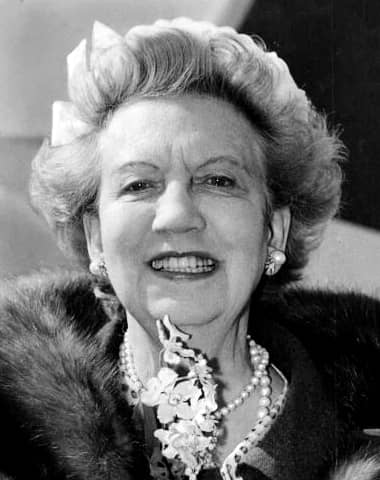
Florence Nightingale Graham [1881-1966] a.k.a. Elizabeth Arden.

Maine Chance Stables in Lexington, Kentucky.
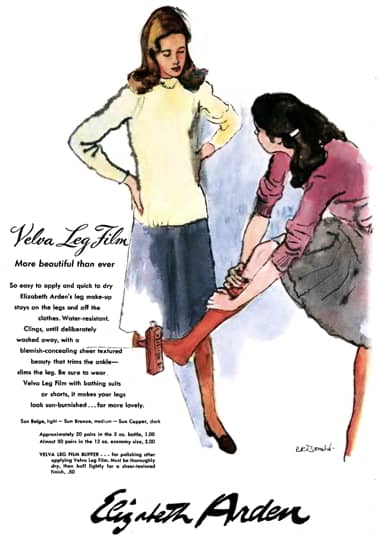
1945 Elizabeth Arden Velva Leg Film.
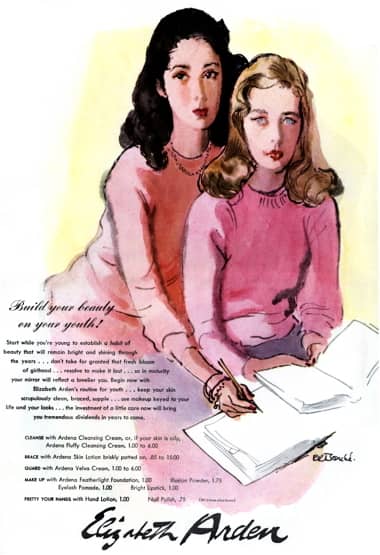
1945 Elizabeth Arden’s routine for youth.
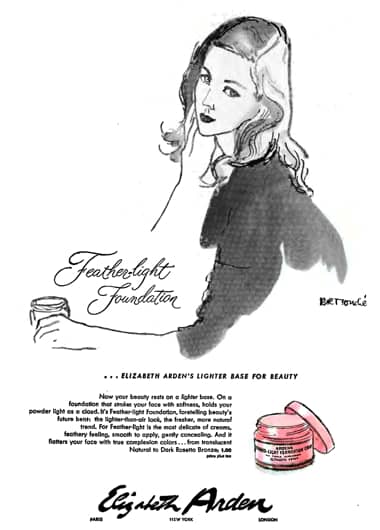
1947 Elizabeth Arden Feather-light Foundation.
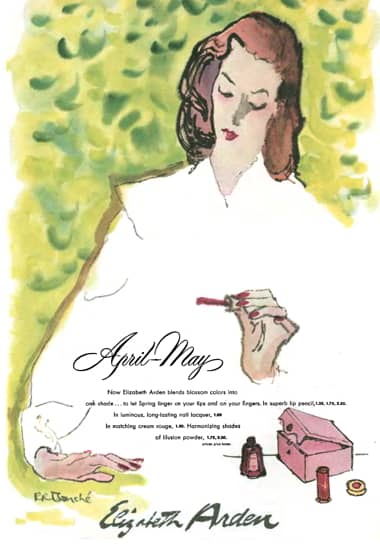
1947 Elizabeth Arden Nail Lacquer with matching Cream Rouge, Lipstick and Illusion Powder.
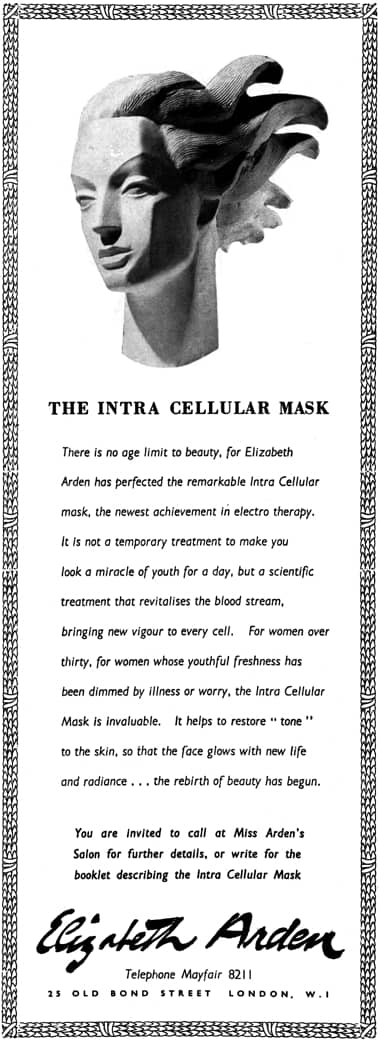
1947 Elizabeth Arden Intra-Cellular Mask.
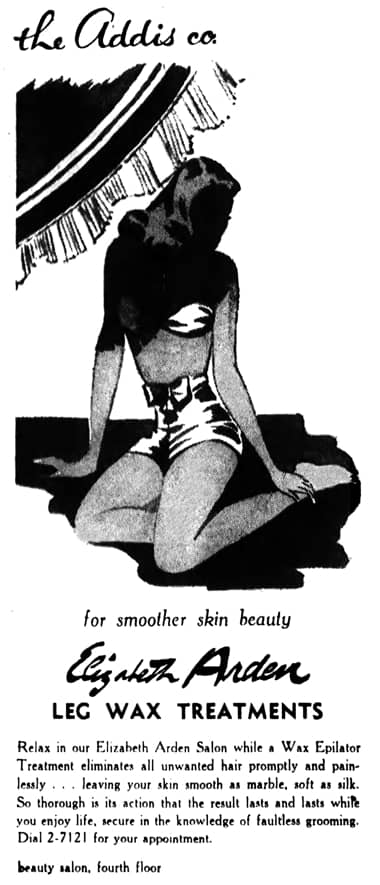
1947 Elizabeth Arden Leg Wax.
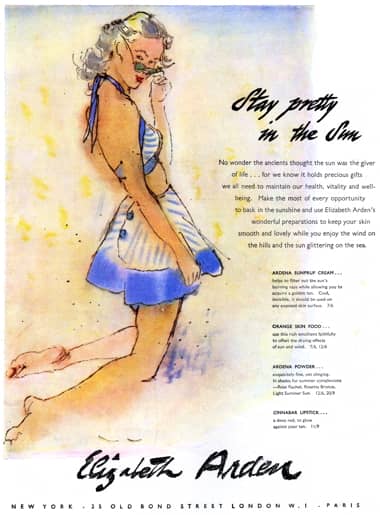
1947 Ardena Sunpruf Cream, Orange Skin Food and Ardena Powder.
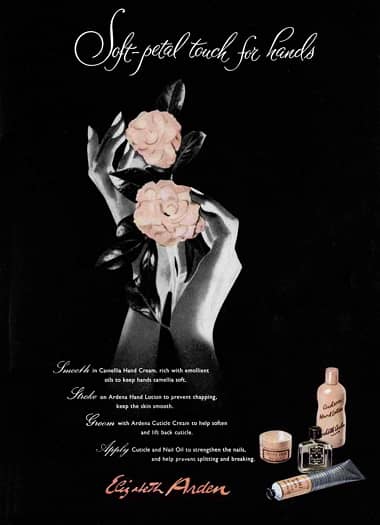
1948 Elizabeth Arden Camellia Hand Cream.
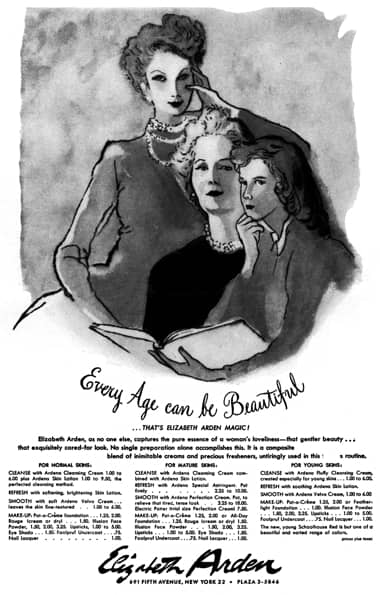
1949 Elizabeth Arden.
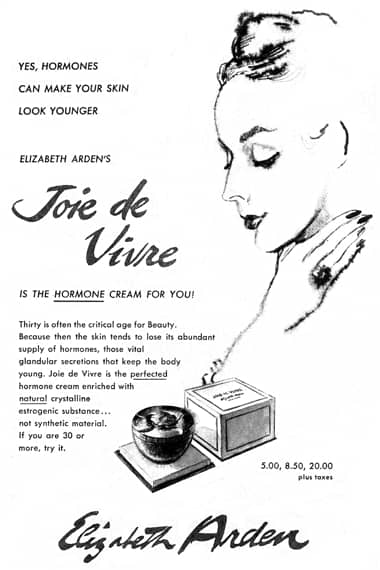
1949 Elizabeth Arden Joie de Vivre Hormone Cream.
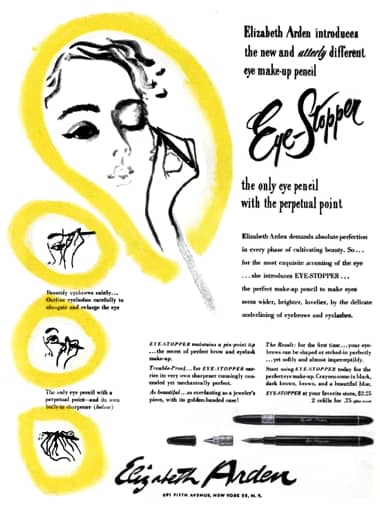
1949 Elizabeth Arden Eye Stopper.
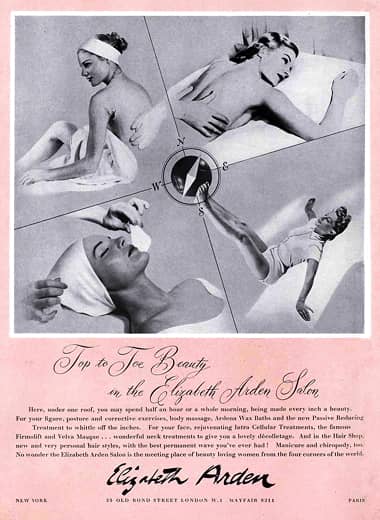
1951 Elizabeth Arden Salon Treatments.
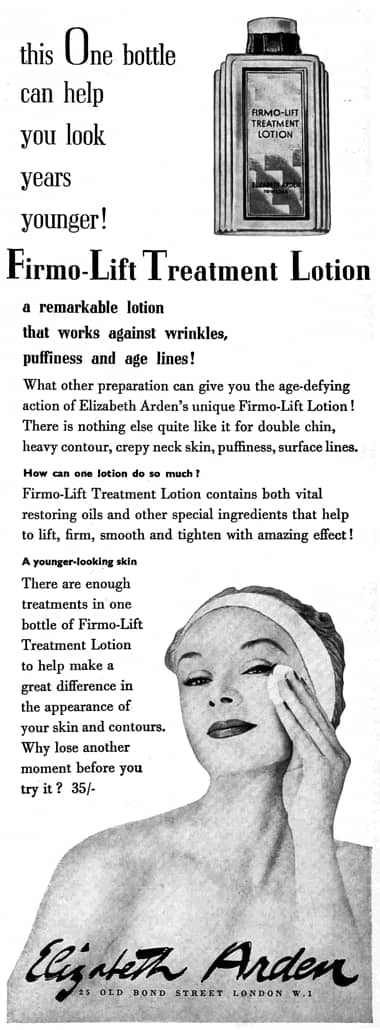
1951 Elizabeth Arden Firmo-Lift.
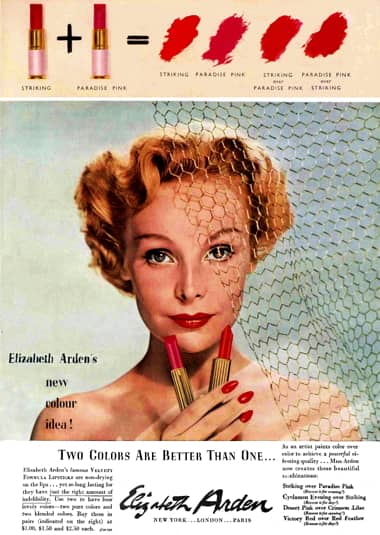
1951 Elizabeth Arden ‘Two colors are better than one’.
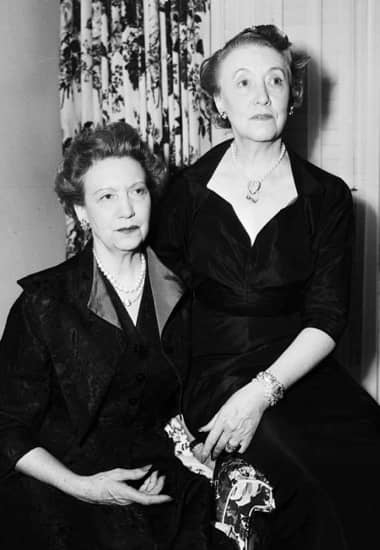
1952 Elizabeth Arden and her younger sister Gladys Maublanc de Boisboucher [1884-1970].
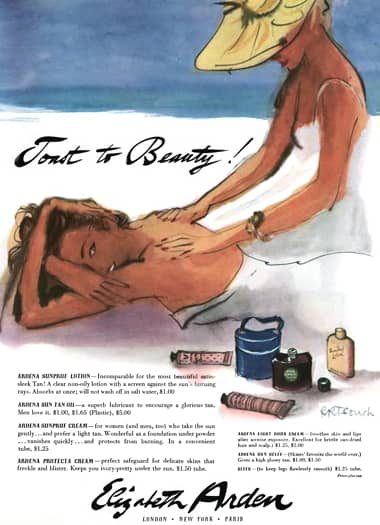
1952 Ardena Sunpruf Lotion, Ardena Sun Tan Oil, Ardena Sunpruf Cream, Ardena Protecta Cream, Ardena Eight hour Cream, Ardena Sun Gelée, and Sleek depilatory.
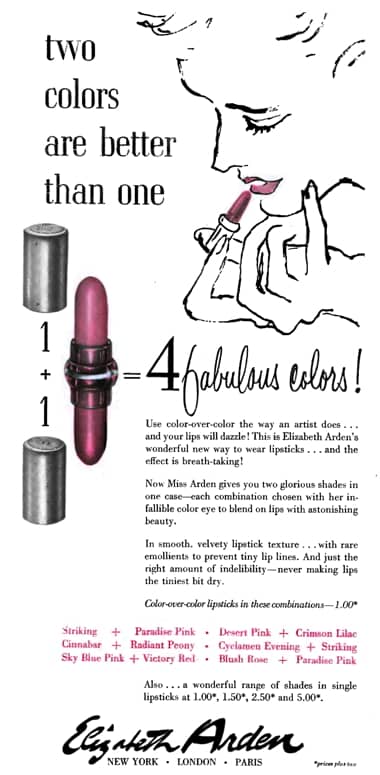
1952 Elizabeth Arden Duet Lipsticks.
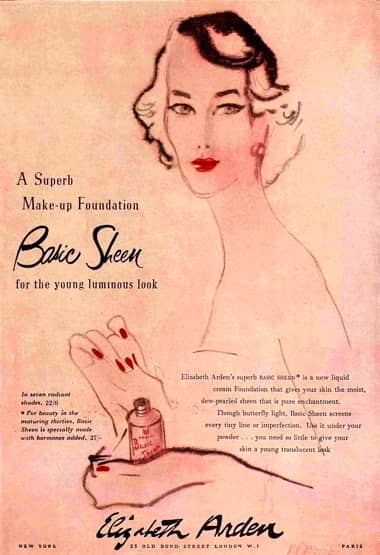
1953 Elizabeth Arden Basic Sheen.
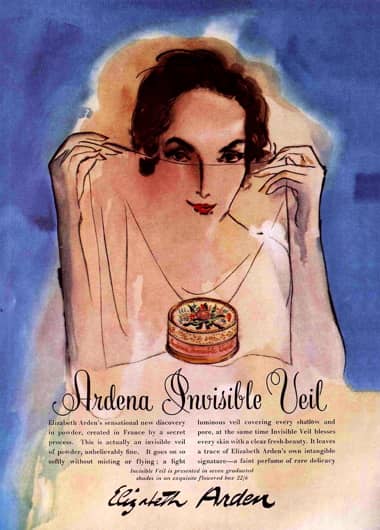
1954 Ardena Invisible Veil
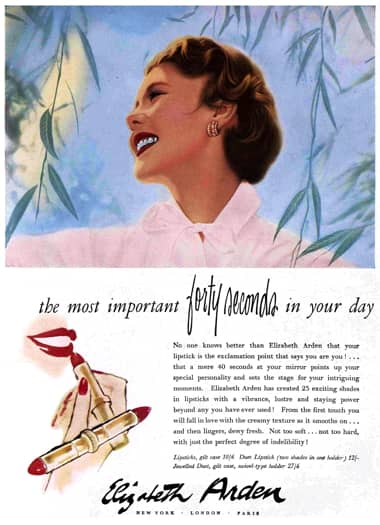
1954 Elizabeth Arden Duet Lipsticks.
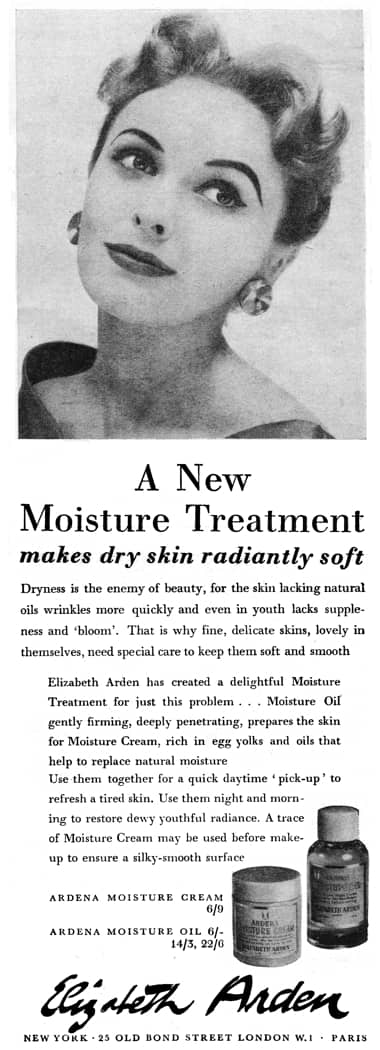
1955 Ardena Moisture Cream and Moisture Oil.
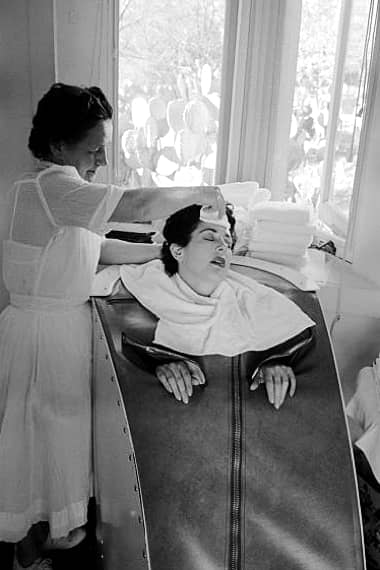
1956 Steam treatments at Maine Chance, Arizona.
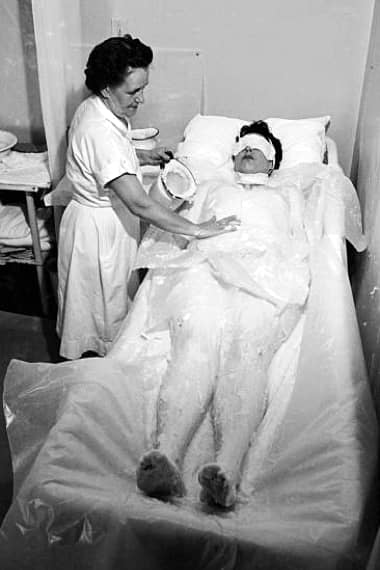
1956 Wax bath at Maine Chance, Arizona.
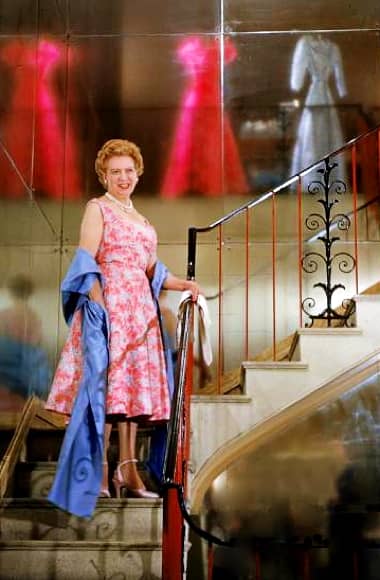
1956 Elizabeth Arden on the stairs of the Fifth avenue salon. Clothes from the Fashion Floor are reflected in the mirror above her.
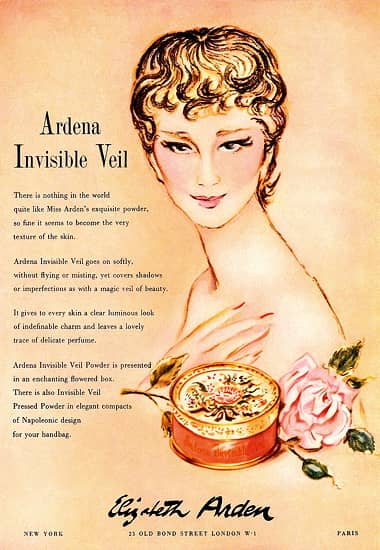
1956 Elizabeth Arden Invisible Veil.
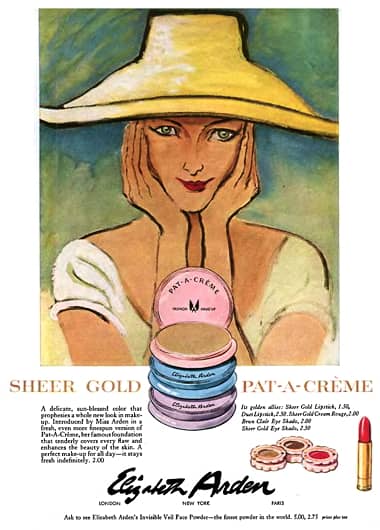
1957 Elizabeth Arden Pat-A-Crème.
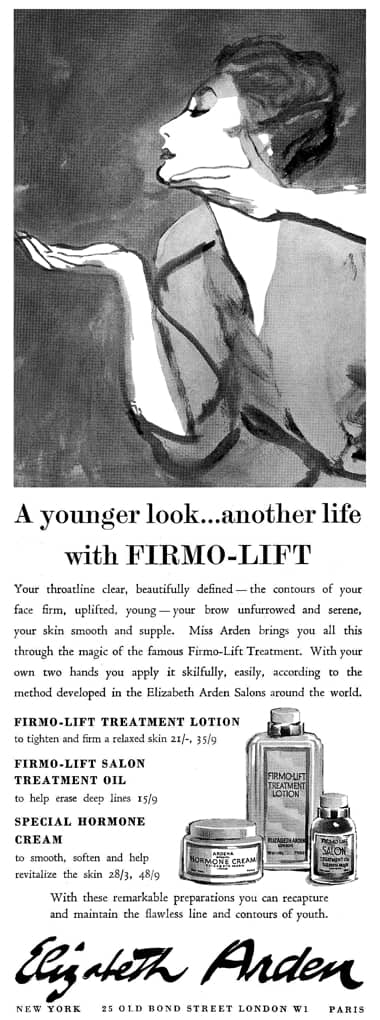
1957 Elizabeth Arden Firmo-Lift.
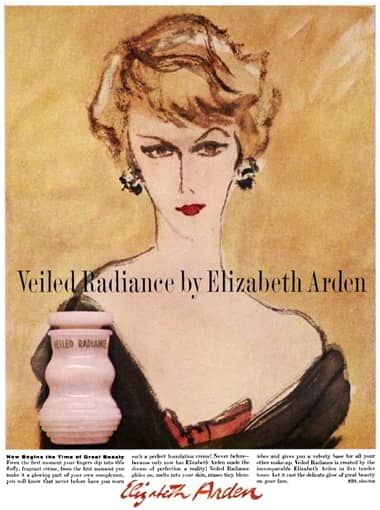
1957 Ardena Veiled Radiance sold in a pink opaline jar. A version sold in a pink and gold plastic tube was added in 1958.
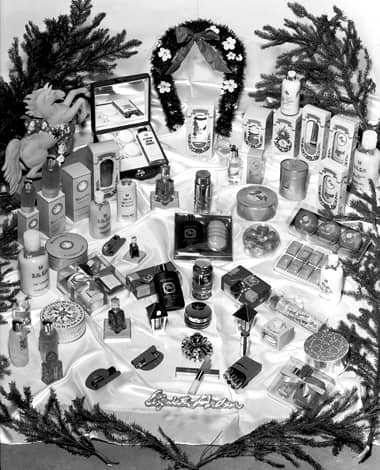
1959 Assorted products by Elizabeth Arden.
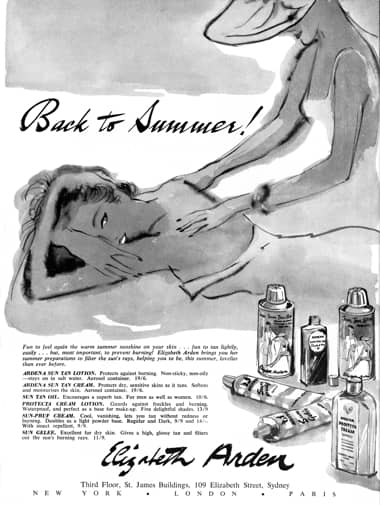
1960 Ardena Sun Tan Lotion, Ardena Sun Tan Cream, Sun Tan Oil, Protecta Cream Lotion, Sun-Pruf Cream and Sun Gelée.
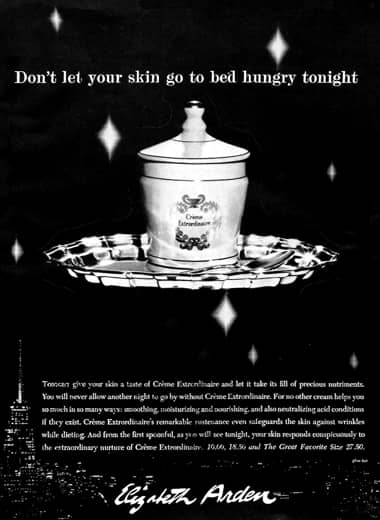
1961 Elizabeth Arden Crème Extrordinaire.
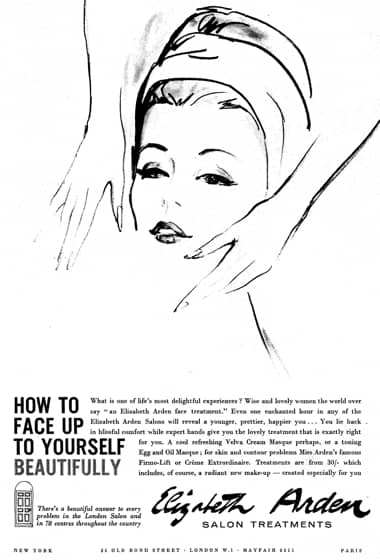
1961 Elizabeth Arden salon treatments.
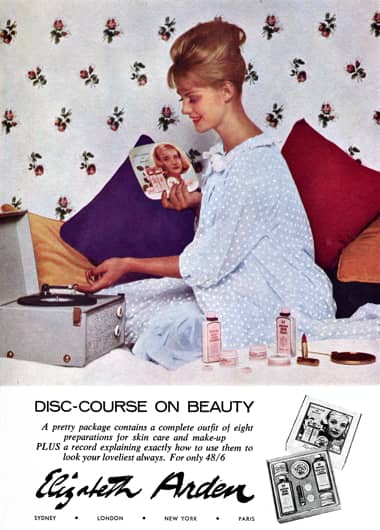
1961 Elizabeth Arden Disc-Course on Beauty. The package consisted of Milky Liquid Cleanser, Ardena Skin Tonic, Velva Cream, Rose Rachel Feather-Light Foundation, Invisible Veil Powder No 5, and an Ananda Pink Jumbo lipstick as well as little miniatures of Eight Hour Cream and Pearly Striking Blue Eye Shado.
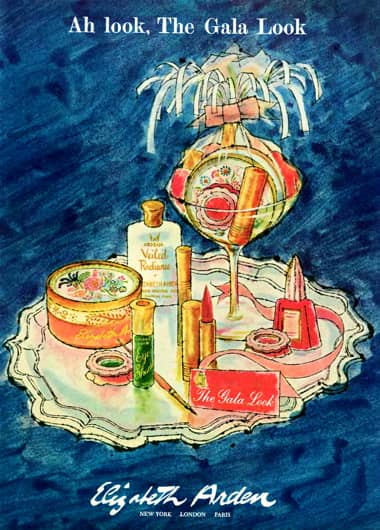
1961 Elizabeth Arden Gala Look: Let’s Dance Lipstick, Nail Lacquer, and Cream Rouge; Silver Gala Veiled Radiance, and Invisible Veil; Dancing Green Liquid, Cream or Stick Eye Shado; and Mascarette
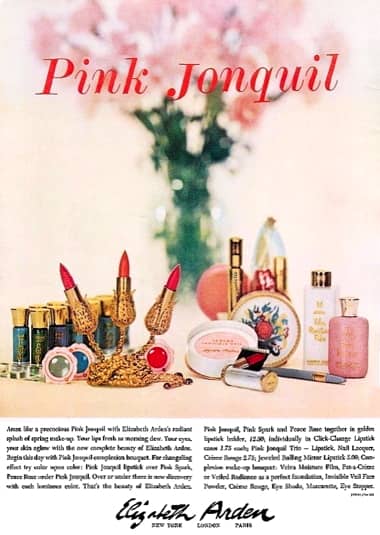
1961 Elizabeth Arden Pink Jonquil.
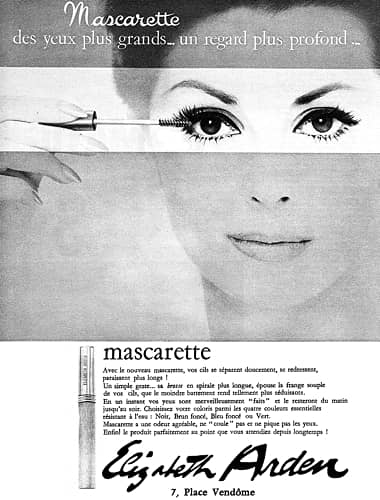
1962 Elizabeth Arden Mascarette.
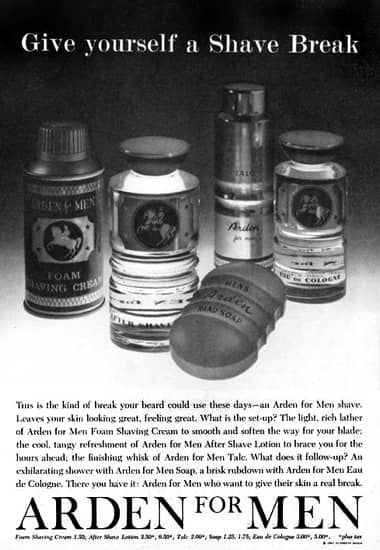
1962 Arden for Men.
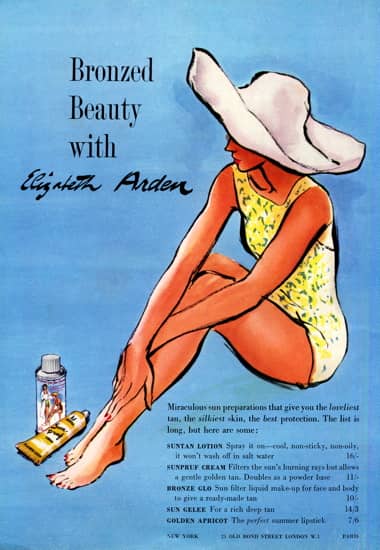
1962 Elizabeth Arden bronzed beauty. Suntam Lotion, Sunpruf Cream, Bronzed Glo, Sun Gelée and Golden Apricot Lipstick.
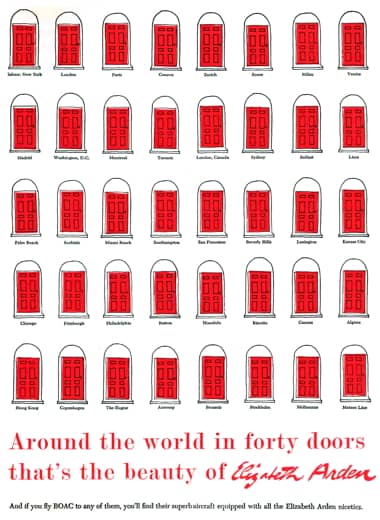
1963 Elizabeth Arden.
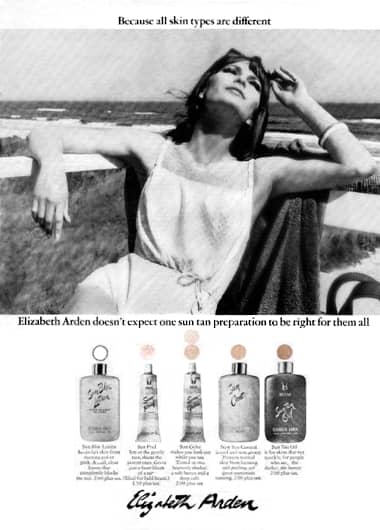
1964 Elizabeth Arden Sun Bloc Lotion, Sun Pruf, Sun Control, and Sun Tan Oil.
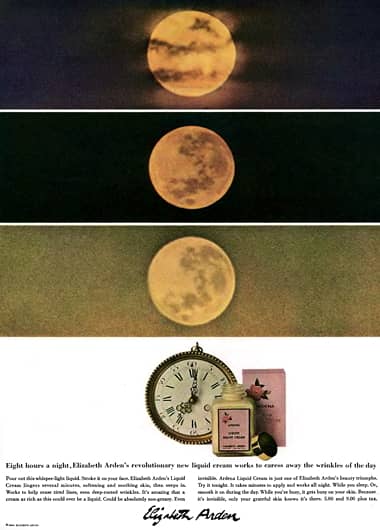
1964 Ardena Liquid Night Cream.
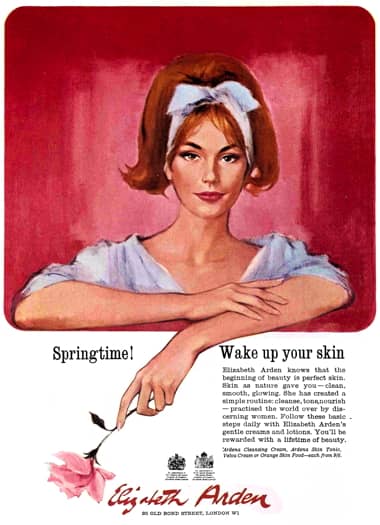
1964 Elizabeth Arden. Note the Royal Warrants from Queen Elizabeth II and Queen Elizabeth, the Queen Mother.
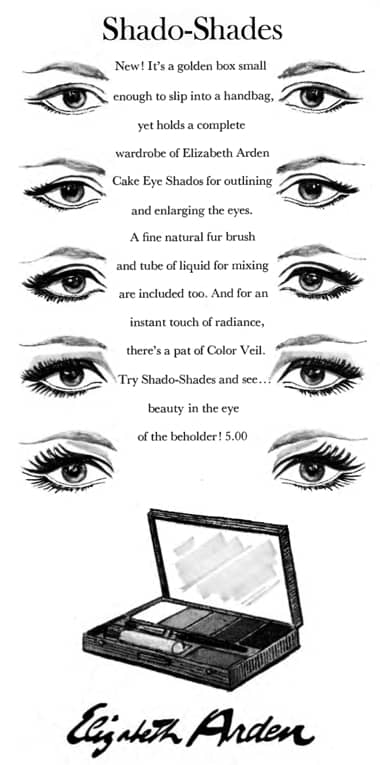
1965 Elizabeth Arden Shado Shades.
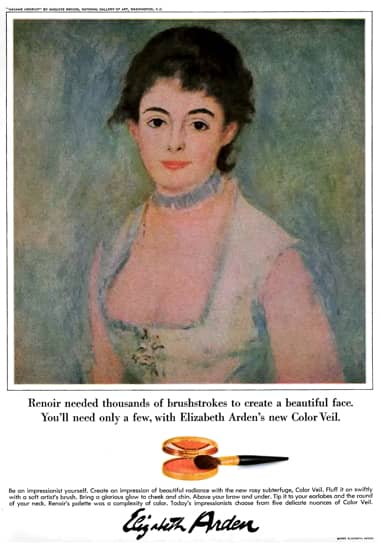
1965 Elizabeth Arden Color Veil.
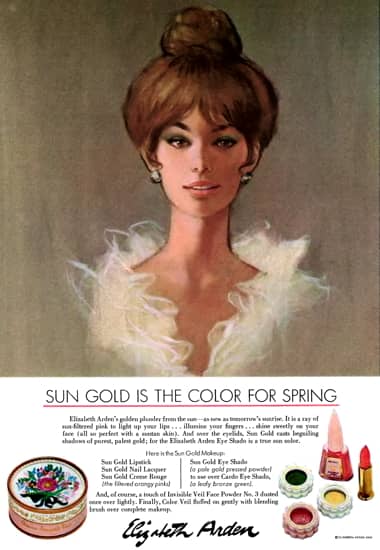
1965 Elizabeth Arden Sun Gold.
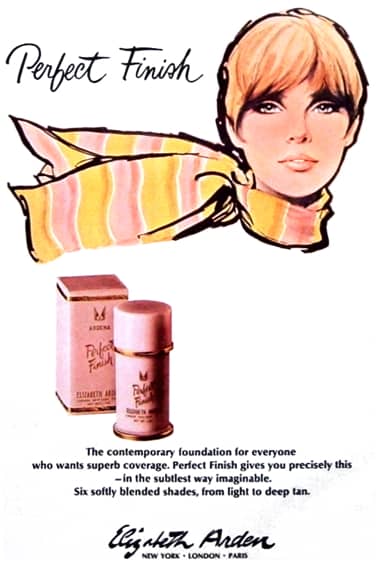
1966 Elizabeth Arden Perfect Finish.
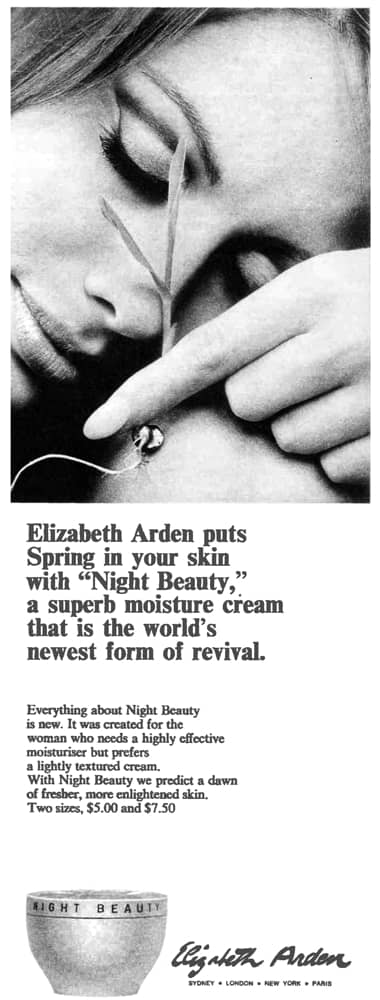
1968 Elizabeth Arden Night Beauty.
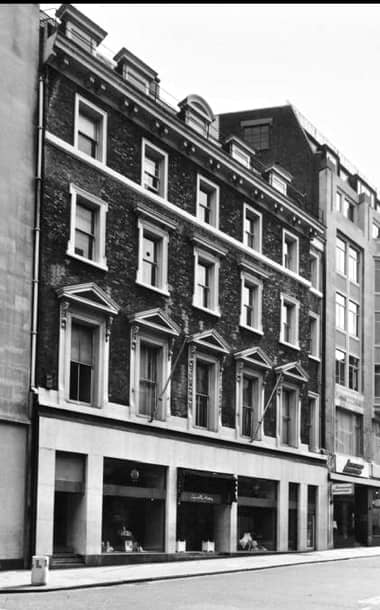
1975 Elizabeth Arden salon in New Bond Street.
